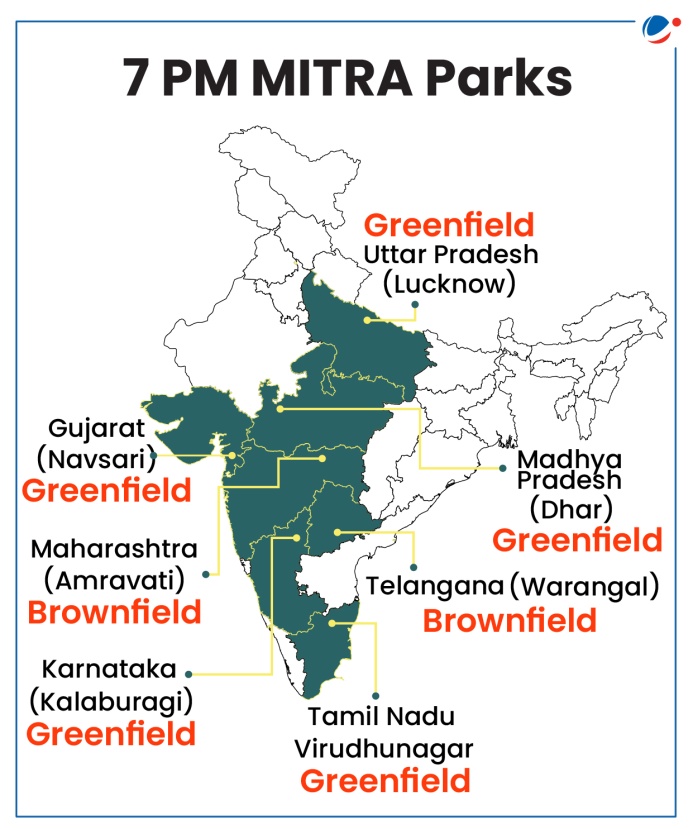
Why in the News?
Recently, the Prime Minister laid the foundation stone of PM MITRA Park in Dhar District in Madhya Pradesh.
About PM MITRA Scheme
- Launched: By the Ministry of Textile with an outlay of ₹ 4,445 crore from 2021-22 to 2027-28.
- Objective: To establish large-scale textile manufacturing hubs with world-class infrastructure and facilities. In 2023, 7 sites were identified across India (refer map).
- These parks will facilitate total value-chain of the textile industry including spinning, weaving, processing, garmenting, textile manufacturing, and processing & printing machinery industry at one place.
- Vision: "5F" vision (Farm → Fibre → Factory → Fashion → Foreign) to integrate and scale up the textile ecosystem.
- Goals
- Attract investment of about ₹70,000 crore
- Generate nearly 20 lakh direct and indirect jobs.
- Eligibility and Selection Criteria for States: Contiguous and encumbrance-free land parcel (at least 1000 acres), a conducive textile and industrial policy and traditional strengths in the textile sector.
- Structure & Implementation:
- Each MITRA Park is to be developed under a Special Purpose Vehicle (SPV) jointly owned by the Centre (49% equity) and the respective State Government (51% equity).
- The mode is largely public-private partnership (PPP), with a master developer selected to build and maintain infrastructure.
- Financial Incentives & Support: Ministry of Textiles will provide financial assistance up to ₹800 crore per park for Greenfield projects and up to ₹500 crore per park for Brownfield projects in the form of
- Development Capital Support (DCS): Up to 30% of project cost
- Greenfield Park (fresh development): Support capped at ₹500 crore per park.
- Brownfield Parks (upgrading existing infrastructure): Support up to ₹200 crore for remaining infrastructure development.
- Competitiveness Incentive Support (CIS): Additional incentive of up to ₹300 crore per park to encourage early setup and incentives for turnover etc.
- Convergence with other Government of India schemes (for power, skill development, logistics) to enhance incentives and reduce duplication.
- A small portion (up to ~10% in area) is allowed as commercial development (real estate, services) to help generate revenue for maintenance and sustainability of common assets.
- Development Capital Support (DCS): Up to 30% of project cost
Why PM MITRA Scheme was launched?
- Fragmentation & Lack of Complete Value Chains: Many units (especially MSMEs / small firms) handle only one or two stages (e.g. spinning, or weaving, or garmenting) rather than a full integrated chain. This hinders economies of scale, slows down response times, increases logistics cost, reduces quality control, etc.
- Infrastructure Bottlenecks: Poor processing & finishing units, lack of eco-friendly effluent treatment, standardization (testing, quality labs), power supply, etc. affects export competitiveness.
- Incubation centres, design labs, and training hubs within the parks can drive product innovation and skilled manpower, especially for emerging areas like technical textiles.
- Centralized effluent treatment plants in the parks ensure sustainable pollution control, addressing stricter global environmental norms and buyer requirements (e.g. in Europe).
- Obsolete Technology & Low Productivity: Many current textile units have older machinery, under-efficient dyeing/processing, and low automation. This raises cost, reduces competitiveness against global players, such as China and Vietnam.
- With plug-and-play factories and fiscal incentives, the parks create an ecosystem to draw domestic and foreign investors, similar to how SEZs attracted electronics manufacturing.
- Underinvestment & Poor Scale: Existing schemes like SITP (Scheme for Integrated Textile Parks) have not achieved size and scale needed for global competitiveness.
- Multiplier Effect: As a labor-intensive and export-oriented sector, integrated parks can generate large-scale jobs, raise rural incomes, and strengthen raw material linkages, creating broad economic impact.
Overview of India's Textile and Apparel Sector
Other Key Government Initiatives & Supports
|
Conclusion
The PM MITRA Scheme seeks to transform India's textile sector into a globally competitive hub by integrating the entire value chain, reducing logistics costs, and upgrading technology. With strong PPP support, fiscal incentives, and job potential, it can boost investment, strengthen exports, and promote sustainable, inclusive growth, advancing the 5F vision.



